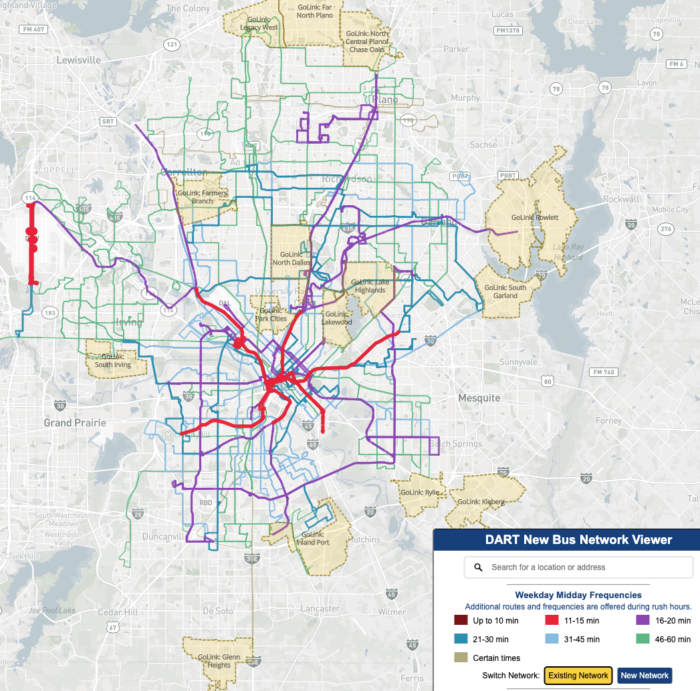The Dallas area’s new bus network goes live on January 24, 2022! It’s the result of our three-year collaboration with the transit agency DART and its member cities. The project relied on extensive input from the community, and the Board, about what kind of transit system they want to see. But it’s still a no-growth network, which means that DART couldn’t add new operating budget. As a result, it’s full of difficult tradeoffs and not everyone will like it.
You can compare the old and new networks at this cool data viewer that we developed. Here is the existing network followed by the new network. Note the frequencies in the legend, without which these maps make no sense.
In general, it’s fewer routes, longer walks in some cases, but higher frequencies. We’ve also:
- established more regular timed-transfer patterns among infrequent routes, especially at South Garland and Addison Transit Centers.
- set feeder routes to 20 or 40 minute frequencies so that they match the 20 minute rail frequency. This is the main reason that you see relatively little expansion of the 15-minute frequencies (red) but a big expansion of the 20-minute frequencies (purples).
- substantially expanded the GoLink demand-response program to provide more coverage. This is a relatively low-cost service for DART, as microtransit goes, because some of the service is provided using ordinary Uber rides under contract with DART.
The result is usually faster access to more destinations. The average area resident will be able to get to 1/3 more jobs in 60 minutes, which means more access to all kinds of opportunity for all kinds of people. This benefit happens almost everywhere (blue in this image) (click to enlarge).
… and the benefit is similar for all races, ages and incomes.
The plan was based on the Board’s decision (not mine) to shift the focus of the service slightly toward a ridership goal and away from a coverage goal. That would have meant service to fewer places, or further away from a few people’s homes, in order to run higher frequencies that produced expanded access to opportunity for most people. Because the sad mathematical fact is: Ridership arises from how useful service is to many people, not how useful it is to absolutely everyone. When we seek to serve absolutely everyone, we’re planning for coverage, not ridership.
But in fact, even though the priorities shifted away from coverage, the final network hardly cuts coverage at all.
None of this means that everyone will be happy. Network changes are always disruptive to some people’s lives. We make sure every decision-maker to know that before they decide to proceed.
Finally, this is not our plan. It’s DART’s plan based on their conversation with the public, and the decision of their Board. We facilitated the design conversations and did the analysis, but we didn’t set the policy that led to the network looking as it does. That’s not an evasion of responsibility. It’s the key to our whole approach to these projects, which is to defer entirely to the community on questions of priorities, and to never make those decisions ourselves.
We hope your new network takes you to good places. Meanwhile, we’ll soon be starting work on a happier project to envision an expanded bus network, a little bit closer to what the community actually needs. So if you’re in the Dallas area, stay involved!




